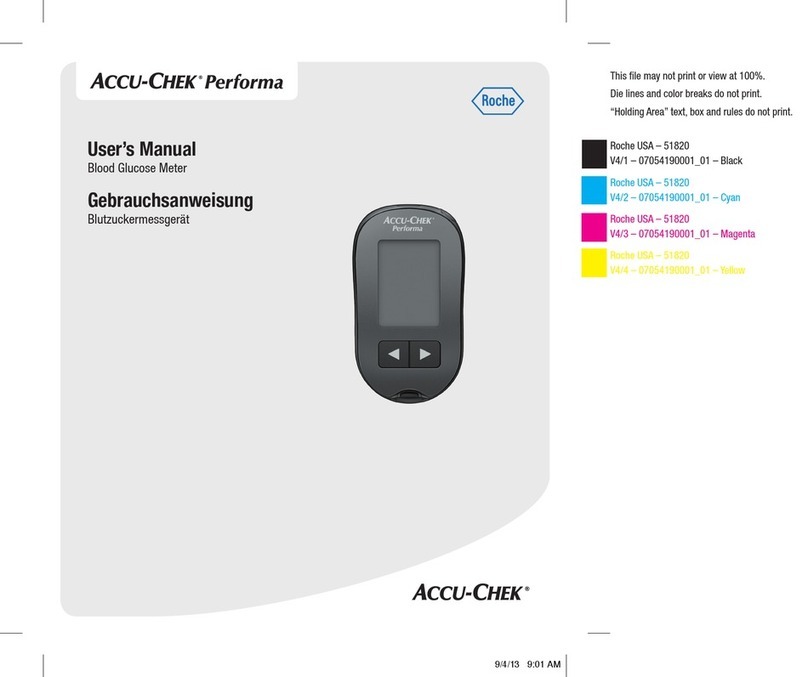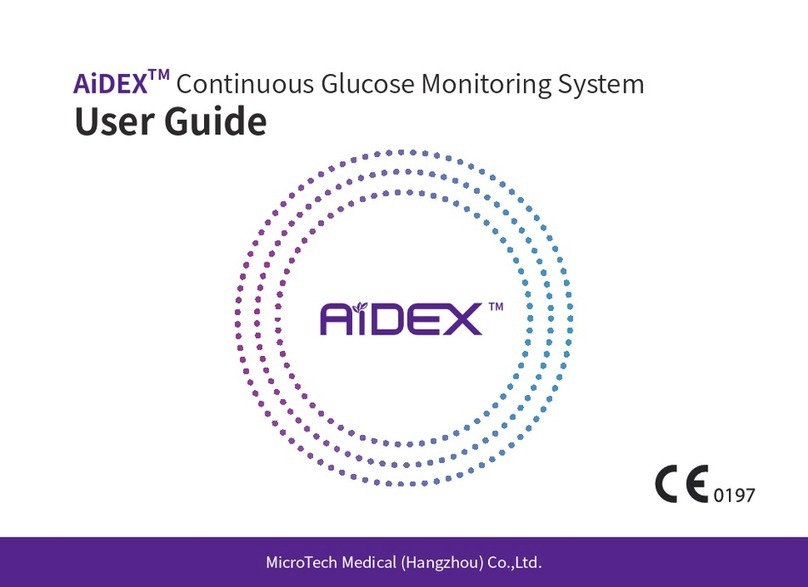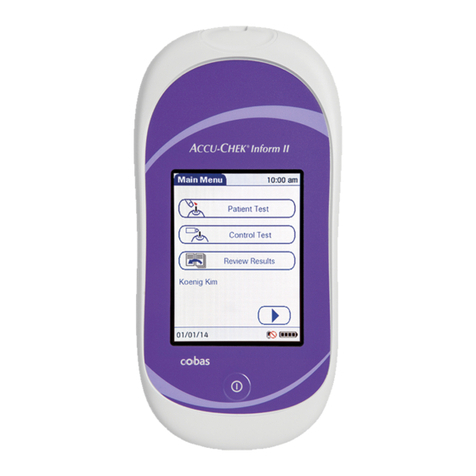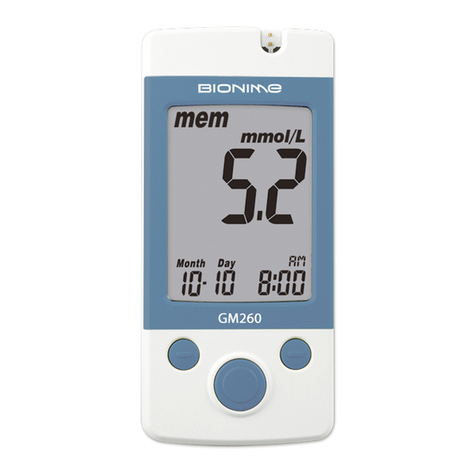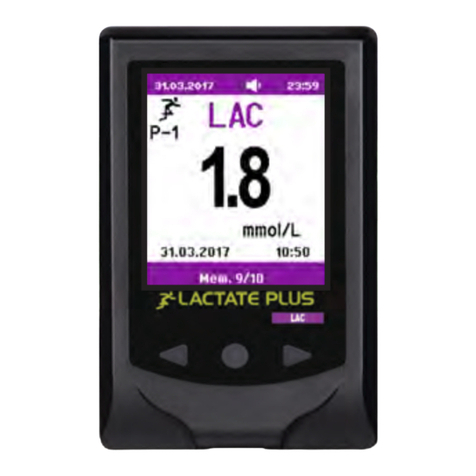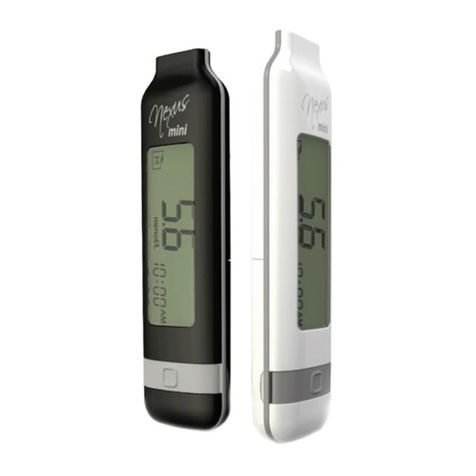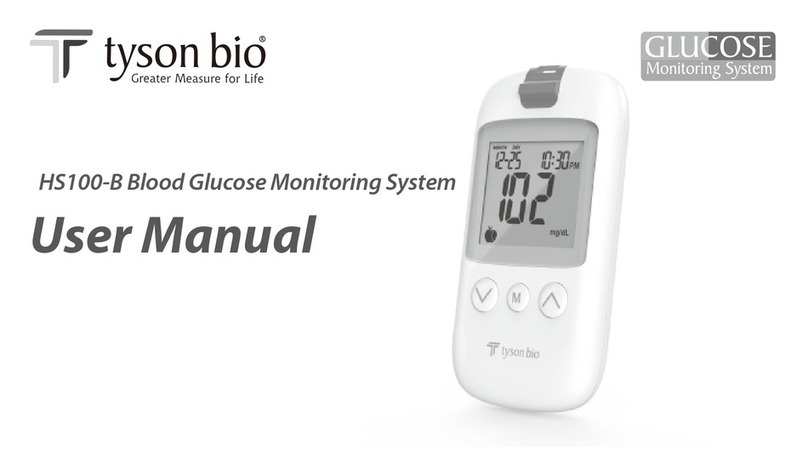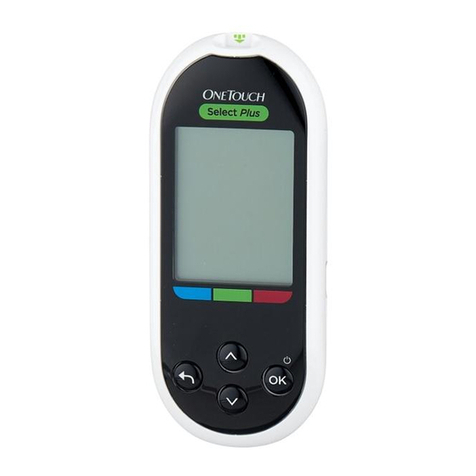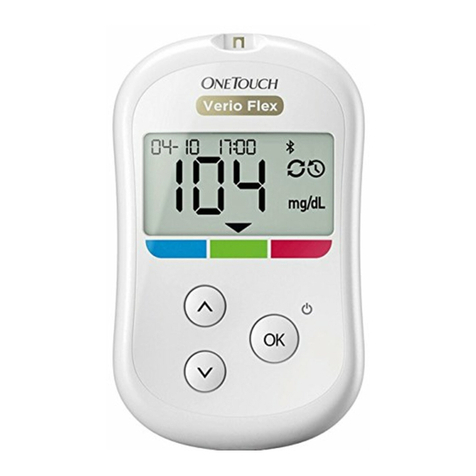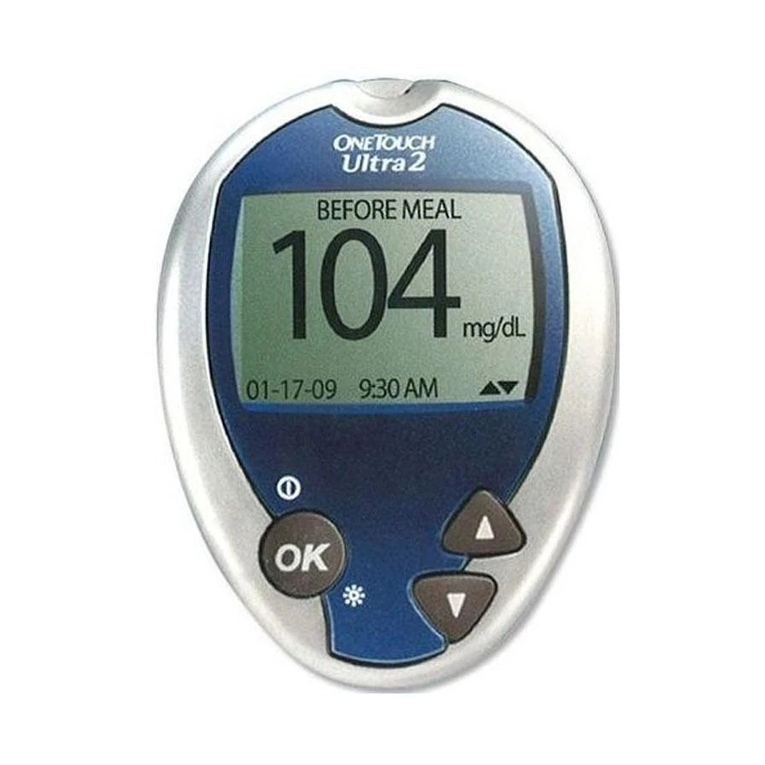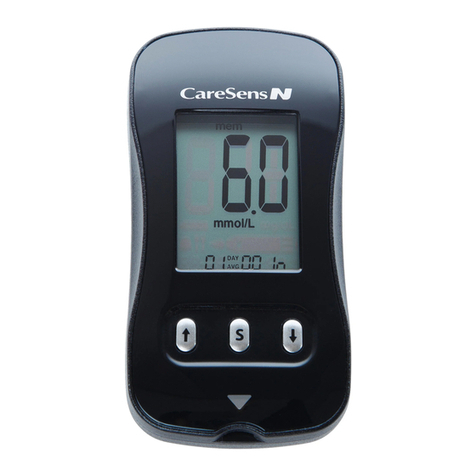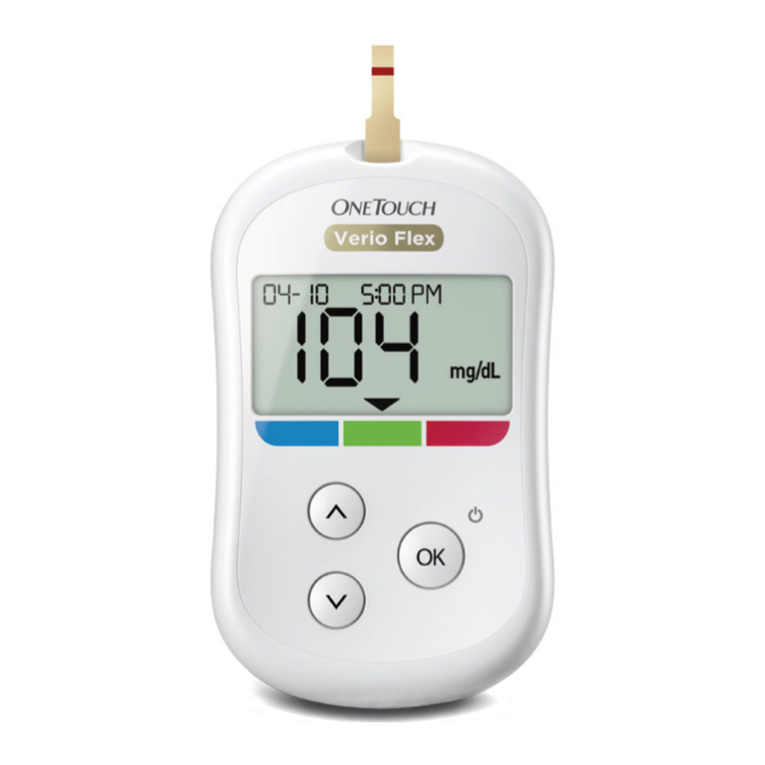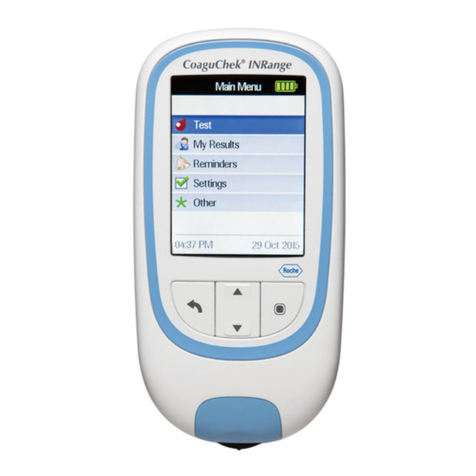Nipro 4Sure Smart Duo User manual

Sure and Simple
OWNER’S MANUAL
Blood Glucose & β-Ketone Monitoring System
IDEAL FOR


Index
1. Safety Information.........................................................................................................1
2. Important Information.................................................................................................2
3. Introduction.....................................................................................................................2
4. Getting Started ...............................................................................................................4
5. Blood Glucose Testing..................................................................................................5
6. β-Ketone Testing ............................................................................................................9
7. Control Solution Testing..............................................................................................13
8. Reviewing Test Results.................................................................................................16
9. Transferring Data............................................................................................................17
10. Maintenance .................................................................................................................18
11. Important Safety Instructions for Healthcare Professionals ........................20
12. Reference Values..........................................................................................................22
13. Symbol Information ...................................................................................................23
14. Troubleshooting ..........................................................................................................25
15. Specications................................................................................................................28
16. Limited Lifetime Warranty Terms and Conditions ...........................................29

EN-1
1. Safety Information
Read the following Safety Information thoroughly before using the device.
• Use this device ONLY for the intended use described in this manual.
• Do NOT use accessories which are not specied by the manufacturer.
• Do NOT use the device if it is not working properly or damaged.
• This device does NOT serve as a cure for any symptoms or diseases. The data
measured is for reference only. Always consult your doctor to have the results
interpreted.
• The blood glucose test strip can be used for the testing of newborns; The β-Ketone
test strip must NOT be used for the testing of newborns.
• Before using this device to test blood glucose or β-Ketone, read all instructions
thoroughly and practice the test. Carry out all the quality control checks as directed.
• Keep the device and testing supplies away from young children. Small items such as
the battery cover, batteries, test strips, lancets and vial caps are choking hazards.
• The use of this instrument in a dry environment, especially if synthetic materials are
present (synthetic clothing, carpets etc.) may cause damaging static discharges that
may cause erroneous results.
• Do NOT use this instrument in close proximity to sources of strong electromagnetic
radiation, as these may interfere with the correct operation.
• Proper maintenance as well as timely calibration of the device together with the
control solution is essential in ensuring the longevity of your device. If you are
concerned about the accuracy of the measurement, please contact the place of
purchase or customer service representative for assistance.
KEEP THESE INSTRUCTIONS IN A SAFE PLACE

EN-2
2. Important Information
• Severe dehydration and excessive water loss may cause readings which are lower
than actual values. If you believe you are suering from severe dehydration, consult a
healthcare professional immediately.
• If your blood glucose or β-Ketone results are lower or higher than usual, and you
do not have symptoms of illness, rst repeat the test. If you have symptoms or
continue to get results higher or lower than usual, follow the treatment advice of your
healthcare professional.
• Use only fresh whole blood sample to test your blood glucose or β-Ketone. Using
other substances will lead to incorrect results.
• If you are experiencing symptoms that are inconsistent with your blood glucose or
β-Ketone test results and you have followed all instructions described in this owner’s
manual, call your healthcare professional.
• We do not recommend using this product on severely hypotensive individuals
or patients in shock. Readings which are lower than actual values may occur for
individuals experiencing a hyperglycaemic-hyperosmolar state, with or without
ketosis. Please consult the healthcare professional before use.
3. Introduction
Intended Use
This system is intended for use outside the body (in vitro diagnostic use) by people
with diabetes at home and by health care professionals in clinical settings as an aid
to monitor the eectiveness of diabetes control. It is intended to be used for the
quantitative measurement of glucose (sugar) and β-hydroxybutyrate (Ketone) in fresh
whole blood samples with following indications.
Home use of blood glucose testing requires capillary blood samples from ngertip
or alternate sites (AST) palm, forearm and upper arm.In addition, health care
professionals may also use arterial and venous blood samples, as well as neonatal
blood from the heel.
For professional use of blood glucose testing, only use heparin for anticoagulation of
arterial, venous and capillary whole blood samples.
Home use of β-Ketone testing requires capillary blood samples from the ngertip only.
(Alternate site testing is not supported). In addition, health care professionals can also
use venous blood samples, however arterial, neonatal and alternate site testing is not
supported.
For professional use of β-Ketone testing, only use heparin for anticoagulation of
venous and capillary whole blood samples.
This system is not intended for use in the diagnosis or screening of diabetes mellitus.

EN-3
Test Principle
Your system measures the amount of glucose or β-Ketone in whole blood. The glucose
or β-Ketone testing is based on the measurement of electrical current generated by
the reaction of glucose or β-Ketone with the reagent of the strip. The meter measures
the current, calculates the blood glucose or β-Ketone level, and displays the result. The
strength of the current produced by the reaction depends on the amount of glucose or
β-Ketone in the blood sample.
Product Overview
10. Bluetooth Indicator
4. Battery Compartment 5.
Display Screen
6. Down Button
8. MAIN Button
9. Micro USB Port
7. UP Button
1. Test Strip Slot
3. Test Strip Ejector
2. Strip Indication Light
Screen Display
10. Blood Glucose Symbol
9. Low battery Symbol
5. Memory Symbol
6. Day Average
7. Warning Symbol 12. Date & Time
11. Measurement Unit
8. Test Strip Symbol
3. Test Result
2. Ketone Warning /
Ketone Symbol
4. Measurement Mode
1. Blood Drop Symbol

EN-4
4. Getting Started
Initial Setup
Please follow the initial setup procedure before using the device for
the rst time or after you have replaced the battery. When the battery
power is extremely low and“ & ” appears on the screen, the
meter cannot be turned on.
Step 1: Enter the Setting Mode
1. The meter turns on automatically once a new battery is inserted.
2. Start with the meter o (no test strip inserted). Press and hold and at the same
time for ve seconds.
Step 2: Conguring the Settings (Date, Time, and Reminder Alarm)
Press or to adjust the value or enable/disable the setting. Then press MAIN
button to conrm the setting and switch to another eld.
Set [Year] Set [Month] Set [Day] Set [Hour]
Set [Minute] Set [Beep On,
Beep O ]
Set [Reminder
Alarm]
Set [Alarm Time
(Hour)]
Set [Alarm Time
(Minute)]

EN-5
Note:
• Press to select Beep On or Beep O. Press MAIN button to conrm.
• When Beep is turned o, the alarm function will remain eective.
• You may set it up to four reminder alarms.
• To turn o the alarm, press or to change On to OFF. Press MAIN button to
conrm.
• When the alarm goes o, the device will automatically turn on. Press or to mute
the alarm. If you do not press or , the device will beep for 2 minutes then switch
o.
• If the device is idle for 2 minutes during the setting mode, it will turn o automatically.
Absorbent Hole
Apply a drop of blood
here. The blood will be
automatically absorbed.
Conrmation Window
This is where you conrm
if enough blood has been
applied to the absorbent hole
in the strip.
Test Strip Handle
Hold this part to insert
the test strip into the slot. Contact Bars
Insert this end of the test strip
into the meter. Push it in rmly
until it will go no further.
5. Blood Glucose Testing
Before Testing Blood Glucose
Blood Glucose Test Strip Appearance
Inserting a Test Strip
Insert the test strip into its slot.
Important!
The front side of test strip should face up when inserting the test strip. Test results
might be wrong if the contact bar is not fully inserted into the test slot.

EN-6
Preparing the Lancing Device
1. Remove the cap.
2. Insert a new lancet rmly into the white lancet holder cup.
3. Remove the protective disk on the lancet.
Hold the lancet rmly in place and twist o the protective disk.
4. Replace the cap until it snaps or clicks into place.
5. Rotate the dial to set the desired lancing depth.
6. Pull the cocking control out until the orange bar appears on the release button
window.
Important!
To reduce the chance of infection:
• Never share a lancet or a lancing device.
• Always use a new, sterile lancet. Lancets are for single use only.
• Avoid getting hand lotion, oils, dirt, or debris in or on the lancets and the lancing
device.
Obtaining the Blood Sample
Please follow the suggestions below before obtaining a drop of blood:
• Wash and dry your hands before starting.
• Select the puncture site either on your ngertips or other body parts.
• Rub the puncture site for about 20 seconds before penetration.

EN-7
Blood from the ngertip
1. Press the lancing device tip rmly against the lower side of your ngertip.
2. Press the release button to prick your nger.
A click indicates that the puncture is complete.
Blood from sites other than the ngertip (For Blood Glucose Test Only)
Alternative site testing (AST) is when individuals check their
blood glucose levels using other areas of the body other than
the ngertips. The 4SURE blood glucose test strips allow AST to
be performed on sites other than the ngertips. Please consult
your health care professional before you begin AST.
We strongly recommend that you perform AST ONLY at the following times:
• During a pre-meal or fasting state (more than 2 hours since the last meal).
• Two hours or more after taking insulin.
• Two hours or more after exercise.
To obtain a blood sample from the alternative sites, please rub the puncture site for
approximately 20 seconds.
1. Replace the lancing device cap with the clear cap.
2. Pull the cocking control out until the orange bar
appears on the release button window.
1
2
Do NOT use AST if:
• You think your blood glucose is low.
• You may not notice if you are hypoglycemic.
• Your AST results are inconsistent with the way you feel.
• You are testing for hyperglycemia.
• Your routine glucose results often uctuate.
Important!
• Choose a dierent spot each time you test. Repeated punctures at the same spot may
cause soreness and calluses.
• Avoid lancing the areas with obvious veins to avoid excessive bleeding.

EN-8
Performing A Blood Glucose Test
1. Insert the blood glucose test strip into its slot. Wait for
the device to display the test strip“ “ , blood drop “
“, and .
2. Press or to adjust the measuring mode, and press MAIN button to conrm it.
• General Tests ( ) - any time of day without regard to time since the last meal (this
is also the default setting).
• AC ( ) - before meal.
• PC ( ) - 2 hours after a meal.
3. Obtain a blood sample.
Use the pre-set lancing device to puncture
your desired site. After penetration, discard
the rst drop of blood with a clean tissue
or cotton. Gently squeeze the punctured
area to obtain another drop of blood. Be
careful NOT to smear the blood sample. The
volume of blood sample must be at least 0.5
microliter (μL) for blood glucose test.
4. Apply the blood sample.
Move your nger to meet the absorbent hole of the test
strip and the blood drop will automatically be drawn into
the test strip. Remove your nger until the conrmation
window is lled. The meter begins to count down. Do not
remove your nger until you hear a beep sound.
5. Read your result.
The results of your blood glucose test will appear
after the meter counts down to 0. The results will
be stored automatically in the meter memory.
• It is recommended to discard the rst drop of blood as it might contain tissue uid,
which may aect the test result.

EN-9
Ketone warning
• When your blood glucose result is higher than
13.3 mmol/L, the meter will display the blood glucose
reading as well as a Ketone warning
( ashing KETONE and ).
• The ketone warning is to notify you that you may be
at risk of elevated Ketone levels and a Ketone test is
recommended.
• For instructions on how to perform a Ketone test, please
see section 6.
Disposing Used Test Strip and Lancet
To remove the used test strip, simply push the Test Strip Ejector button upward to
eject the used test strip. The device will automatically turn o after the test strip is
removed.
To remove the used lancet, remove the lancet from the lancing device after you have
nished testing. Discard your used strip and lancet properly in a puncture-resistant
container.
Important!
The used lancet and test strip may be biohazards. Please consult your health-care
provider for proper disposal which complies with your local regulations.
6. β-Ketone Testing
Before Testing β-Ketone
Calibration
You must calibrate the device every time you begin to use a new box of β-Ketone test
strips by setting the meter with the correct code. To ensure test accuracy, make sure
the code number displayed on the display screen matches the number printed on the
test strip vial or individual foil pack.
How to Code Your Meter
1. You will receive a code strip with every new pack of
β-Ketone test strips. Insert the code strip into the test
slot of the device. Wait for the device to display the code
number.
623

EN-10
2. Checking the Code Number
Make sure that the code number displayed on the
device matches the number on the individual foil pack
before you proceed.
If it matches, you can proceed with your test.
Otherwise, please stop testing and repeat the
calibration procedure.
If the problem persists, contact Customer Service for
further assistance.
2.0 ~ 3.3
623
mmol/L
ForaCare Suisse AG
Important!
• It is important to make sure that the number on the code strip is the same as the
number that is displayed on the meters LCD screen and on the test strip's individual
foil pack. Failure to do so will cause in accurate results.
3. Remove the code strip, the display will show “ ” indicating the device has
nished coding and is ready for β-Ketone testing.
β-Ketone Test Strip Appearance
Absorbent Hole
Apply a drop of blood
here. The blood will be
automatically absorbed.
Conrmation Window
This is where you conrm
if enough blood has been
applied to the absorbent hole
in the strip.
Test Strip Handle
Hold this part to insert
the test strip into the slot.
Contact Bars
Insert this end of the test strip
into the meter. Push it in rmly
until it will go no further.
Inserting a Test Strip
Insert the test strip into its slot.
Important!
The front side of test strip should face up when inserting the test strip. Test results
might be wrong if the contact bar is not fully inserted into the test slot.

EN-11
Preparing the Lancing Device
1. Remove the cap.
2. Insert a new lancet rmly into the white lancet holder cup.
3. Remove the protective disk on the lancet.
Hold the lancet rmly in place and twist o the protective disk.
4. Replace the cap until it snaps or clicks into place.
5. Rotate the dial to set the desired lancing depth.
6. Pull the cocking control out until the orange bar appears on the release button
window.
Important!
To reduce the chance of infection:
• Never share a lancet or a lancing device.
• Always use a new, sterile lancet. Lancets are for single use only.
• Avoid getting hand lotion, oils, dirt, or debris in or on the lancets and the lancing
device.
Obtaining the Blood Sample
Please follow the suggestions below before obtaining a drop of blood:
• Wash and dry your hands before starting.
• Select the puncture site either on your ngertips or other body parts.
• Rub the puncture site for about 20 seconds before penetration.
Blood from the ngertip
1. Press the lancing device tip rmly against the lower side of your ngertip.

EN-12
2. Press the release button to prick
your nger. A click indicates that the
puncture is complete.
Important!
• Choose a dierent spot each time you test. Repeated punctures at the same spot may
cause soreness and calluses.
• Avoid lancing the areas with obvious veins to avoid excessive bleeding.
• It is recommended to discard the rst drop of blood as it might contain tissue uid,
which may aect the test result.
Performing a β-Ketone Test
1. Insert the β-Ketone test strip into its slot. Wait for the
device to display the test strip“ “ , blood drop “ “,
and KETONE.
2. Obtain a blood sample.
Use the pre-set lancing device to puncture your
desired site. After penetration, discard the rst drop
of blood with a clean tissue or cotton. Gently squeeze
the punctured area to obtain another drop of blood.
Be careful NOT to smear the blood sample. The volume of blood sample must be at
least 0.8 microliter (μL) for blood glucose test.
3. Apply the blood sample.
Move your nger to meet the absorbent hole of the test
strip and the blood drop will automatically be drawn into
the test strip. Remove your nger when the conrmation
window is lled. The meter begins to count down. Do not
remove your nger until you hear a beep sound.
4. Read your result.
The results of your β-Ketone test will appear after
the meter counts down to 0. The results will be
stored automatically in the meter memory.

EN-13
Disposing Used Test Strip and Lancet
To remove the used test strip, simply push the Test Strip Ejector button upward to
eject the used test strip. The device will automatically turn o after the test strip is
removed.
To remove the used lancet, remove the lancet from the lancing device after you have
nished testing. Discard your used strip and lancet properly in a puncture-resistant
container.
Important!
The used lancet and test strip may be biohazards. Please consult your health-care
provider for proper disposal which complies with your local regulations.
7. Control Solution Testing
Important!
Please note there are two main types of 4SURE control solution available;
1. 4SURE blood glucose control solution (Level 1, 2, 3). This solution contains a known
amount of glucose that reacts with the 4SURE blood glucose test strips and is used to
ensure your meter and test strips are working correctly.
2. 4SURE β-Ketone control solution (level 1, 2). This solution contains a known amount
of β-Ketone that reacts with the 4SURE β-Ketone test strips and is used to ensure
your meter and test strips are working correctly.
Only use 4SURE blood glucose control solution to perform a blood glucose control
tests. Only use 4SURE β-Ketone control solution to perform a β-Ketone control test.
Control solution is not provided within your meter starter kit but is available from
customer service. Tel: 0800 08 588 08.
Advice on when to perform a Control Solution Test:
9 You suspect the device or test strips are not working properly.
9 Your blood glucose or β-Ketone test results are not consistent with how you feel, or
if you think the results are not accurate.
9 You have dropped or think you may have damaged the device.
To perform a blood glucose control solution test, do the following:
1. Insert the blood glucose test strip into the test slot of
the device. Wait for the device to display the test strip“
“ and blood drop “ “.

EN-14
2. Apply the 4SURE blood glucose control solution. Shake the control solution vial
thoroughly before use. Squeeze out a drop and wipe it o, then squeeze another
drop and place it on the top of the vial cap. Hold the device to move the absorbent
hole of the test strip to touch the drop. Once the conrmation window is lled
completely, the device will begin counting down.
Note:
To avoid contaminating the control solution, do not directly apply the control solution
onto a strip.
3. Read and compare the result. After counting down to 0, the test result of the control
solution will appear on the display. Compare this result with the range printed on
the test strip vial and it should fall within this range. If the test result is out of range,
read the instructions again and repeat the control solution test.
6.5 ~ 8.8
4. The meter will detect the dierence between control solution and blood samples
automatically. It will automatically marks the result as a control solution test with
“ ” display.
Note:
• Control solution test results are stored in the memory.
• The control solution range printed on the test strip vial is for control solution use only.
It is not a recommended range for your blood glucose level.
• Refer to the Maintenance section for important information about your control
solutions.
Out-of-range results:
If you continue to get results that fall outside the range printed on the test strip vial, it
means that the meter and/or strips might not be working properly.

EN-15
To perform a β-Ketone control solution test, do the following:
1. Insert the β-Ketone test strip into the test slot of the
device. Wait for the device to display the test strip“
“ and blood drop “ “.
2. Apply the 4SURE β-Ketone control solution. Shake the control solution vial
thoroughly before use. Squeeze out a drop and wipe it o, then squeeze another
drop and place it on the top of the vial cap. Hold the device to move the absorbent
hole of the test strip to touch the drop. Once the conrmation window is lled
completely, the device will begin counting down.
Note:
To avoid contaminating the control solution, do not directly apply the control solution
onto a strip.
3. Read and compare the result. After counting down to
0, the test result of the control solution will appear on
the display. Compare this result with the range printed
on the individual foil pack and it should fall within
this range. If the test result is out of range, read the
instructions again and repeat the control solution test. 2.0~3.3
623
mmol/L
4. The meter will detect the dierence between control solution and blood samples
automatically. It will automatically marks the result as a control solution test with
“ ” display.
Note:
• Control solution test results are stored in the memory.
• The control solution range printed on the individual foil pack is for control solution
use only. It is not a recommended range for your blood glucose level.
• Refer to the Maintenance section for important information about your control
solutions.

EN-16
8. Reviewing Test Results
Your device stores the 1000 most recent test results along with respective dates and
times in its memory. To enter the device memory, start with the device switched o.
To review all test results, do the following:
1. Press MAIN button or . The “ ” icon appears on the screen.
2. Press MAIN to review the test results stored in the device.
Press or repeatedly to review other test results stored in the device. After the
last test result, press MAIN again and the device will be turned o.
To review the day-average test results, do the following:
1. Press to enter memory mode for average results with “ ” and
displayed on the screen. Your 7-day average result measured in general mode will
appear on the display.
2. Press or to review 7, 14, 30, 60 and 90-day
average results stored in each measuring mode in the
order of Gen, AC, then PC.
Note:
• Press and hold MAIN for 5 seconds to exit the memory mode or leave it without any
action for 2 minutes. The device will turn o automatically.
• If using the device for the rst time, the“---” icon will appear when you recall the test
results or review the average result. This indicates that there is no test result in the
memory.
• Control solution results are NOT included in the day average.
Out-of-range results:
If you continue to get results that fall outside the range printed on the individual foil
pack, it means that the meter and/or strips might not be working properly.

EN-17
9. Transferring Data
Data Transmission to Smart Phone via Bluetooth
You can use your device with an iOS (5.0.1 or higher) Android system (4.3 API Level 18
or higher) to download data from your 4SURE Smart Duo via Bluetooth. Follow the
steps below to transmit data from your 4SURE Smart Duo. Please contact Nipro Europe
customer service for information regarding available Apps.
1. Turn on the Bluetooth function on your smart phone and open the App you wish to
pair with.
2. After completion of measuring mode or memory mode on your 4SURE meter
system, the Bluetooth will automatically be activated and the Bluetooth indicator
will start to ash.
3. Follow the instructions on your App to pair the two devices.
4. Once the devices are paired, whenever your 4SURE meter turns o after a test, the
Bluetooth will be initiated and data automatically transferred. If your mobile device
is not within receiving range or switched o, the Bluetooth on your 4SURE meter will
automatically deactivate after 2 minutes.
Note:
• While the meter is in transmission mode, it will be unable to perform a blood glucose
or β-Ketone test.
• Make sure your device with iOS or Android system has turned on its Bluetooth before
transmitting the data and the meter is within the receiving range.
Data Transmission to PC via Micro USB Cable
1. Install the software on your computer (Your PC will need window 8 or higher)
Download 4SURE Diabetes Manager and follow the instructions to install the
software on your computer.
2. Connect the device with your computer using a Micro
USB Cable
Connect the Micro USB cable to the USB port on your
computer. With 4SURE Smart Duo switched o, connect
the other end of the Micro USB cable to the 4SURE Smart
Duo data port. “ ” will appear on the meter display,
indicating that the meter is in communication mode.
3. Transfer data to your computer
Follow the software on-screen instructions to transmit data. Remove the cable and
the device will automatically turn o.
Note:
• While the meter is in transmission mode, it will be unable to perform a blood glucose
test.
Table of contents
Other Nipro Blood Glucose Meter manuals

Nipro
Nipro True2go User manual
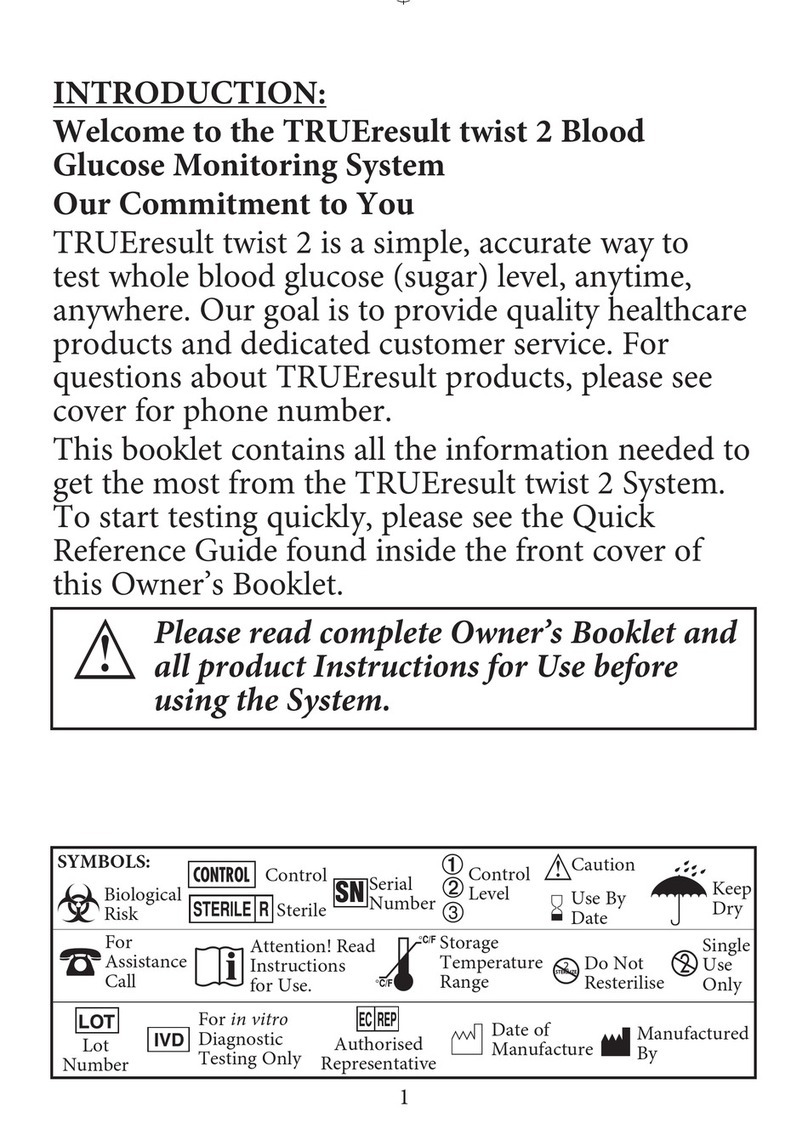
Nipro
Nipro TrueResult Twist 2 User manual

Nipro
Nipro GlucoKey Connect TD-4183D/GD82a User manual
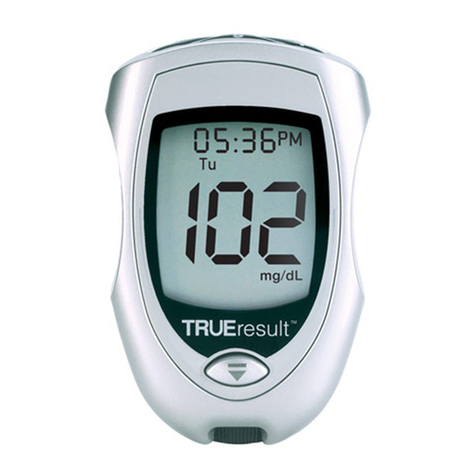
Nipro
Nipro TrueResult User manual
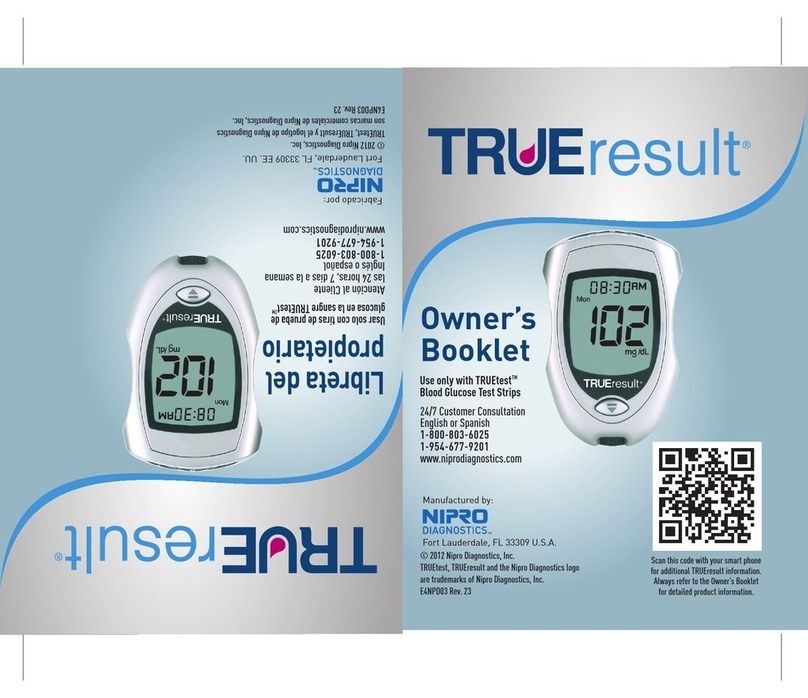
Nipro
Nipro TrueResult User manual
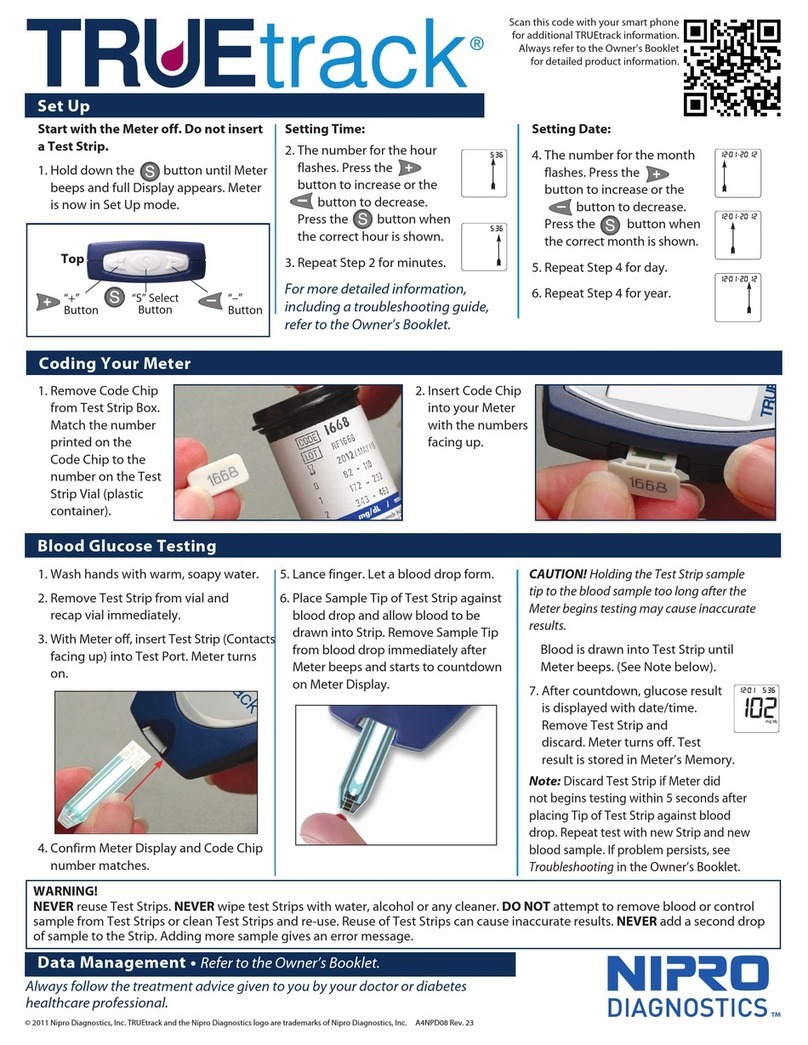
Nipro
Nipro TRUEtrack User manual

Nipro
Nipro TrueResult User manual
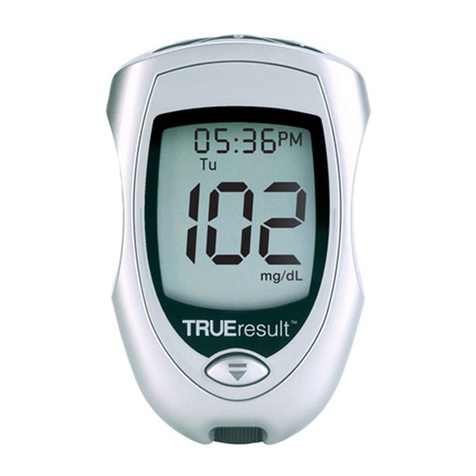
Nipro
Nipro TrueResult User manual
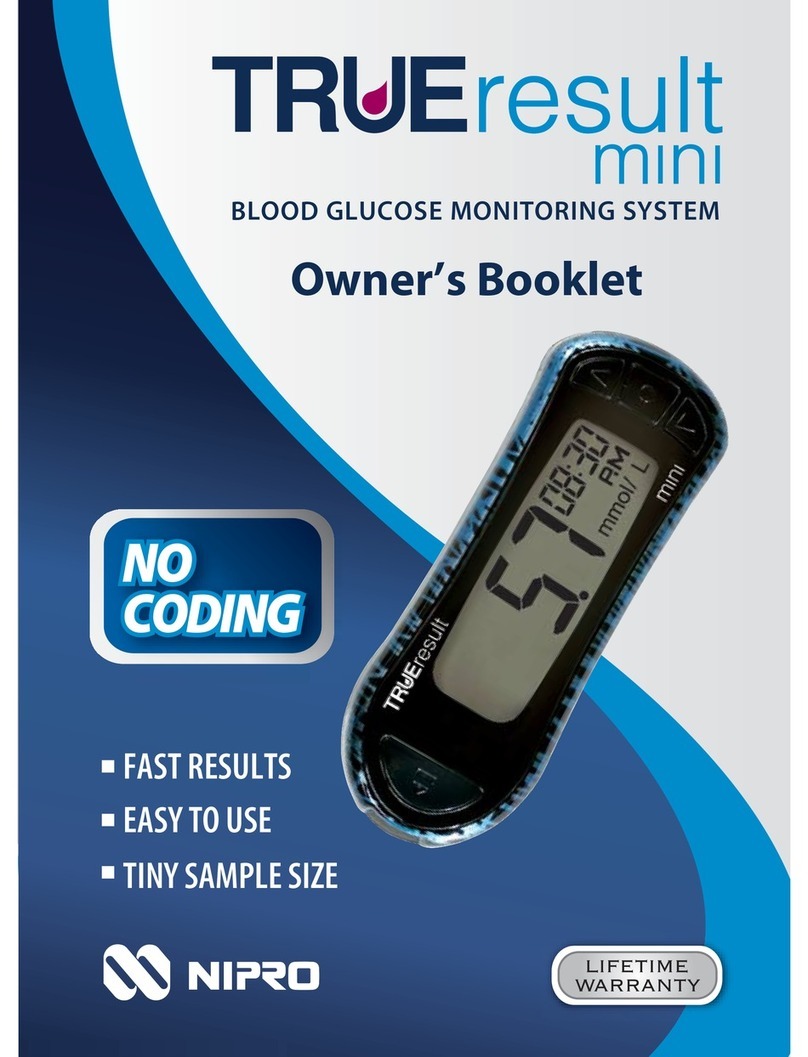
Nipro
Nipro TRUEresult mini User manual
